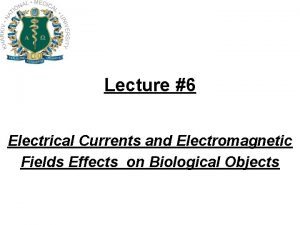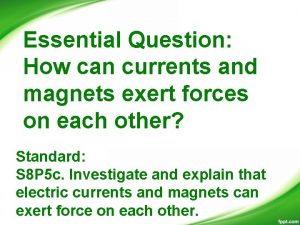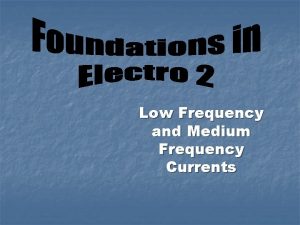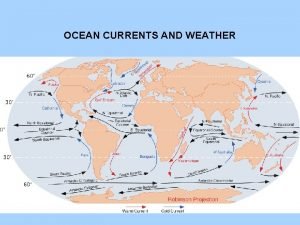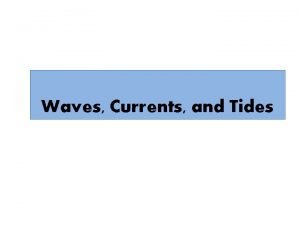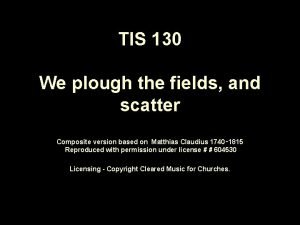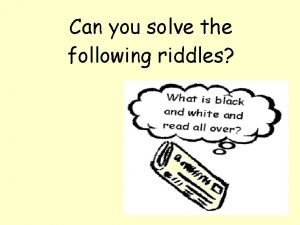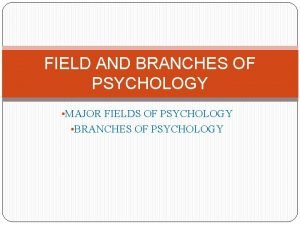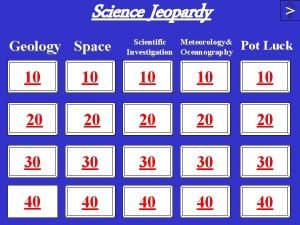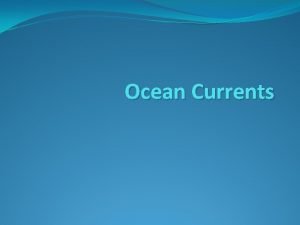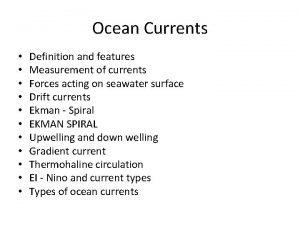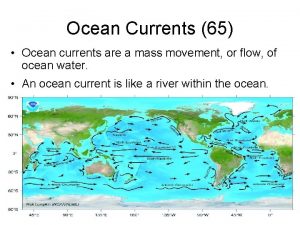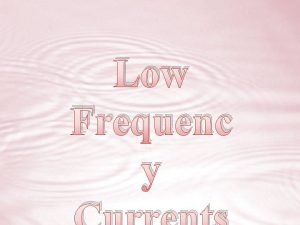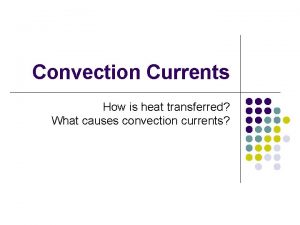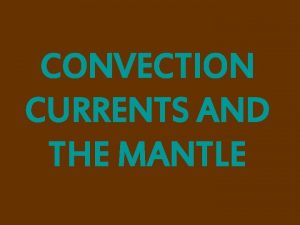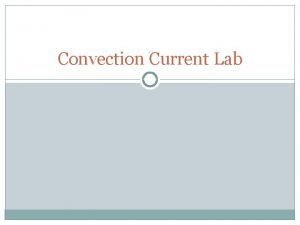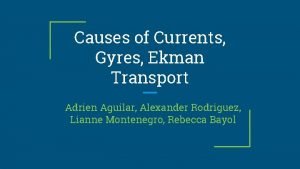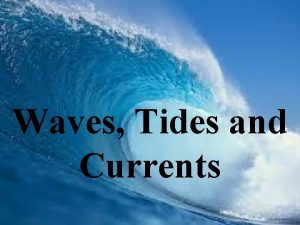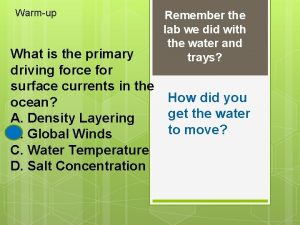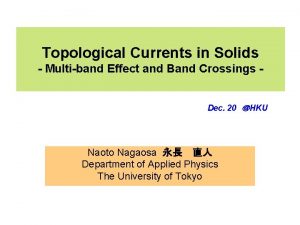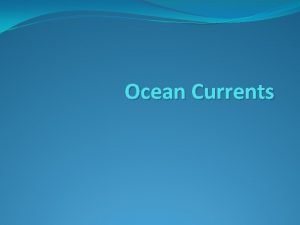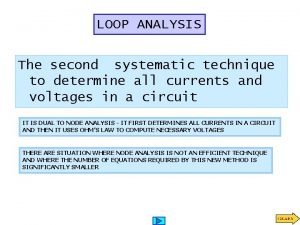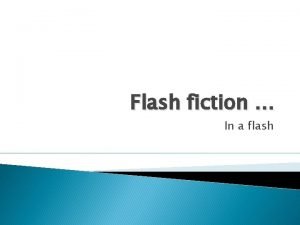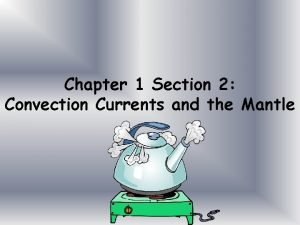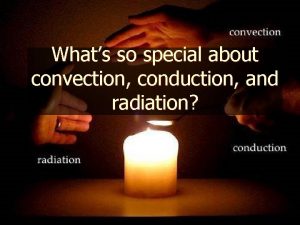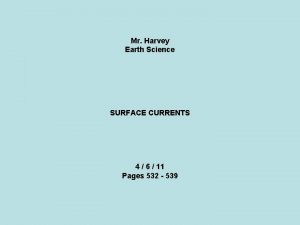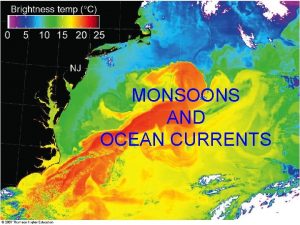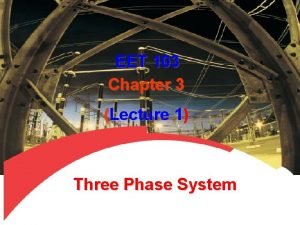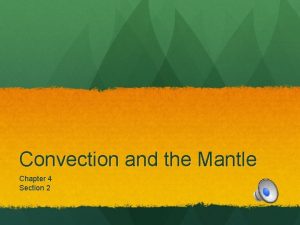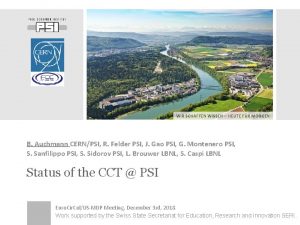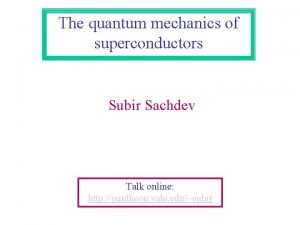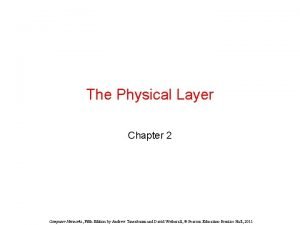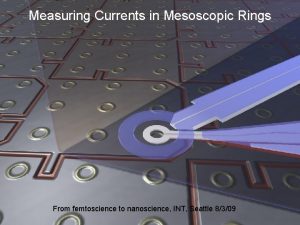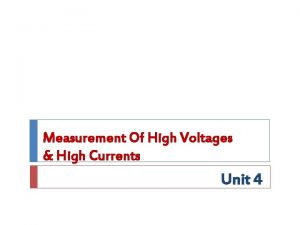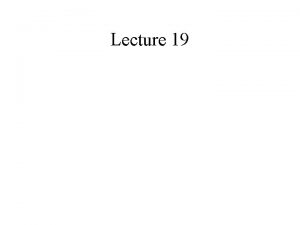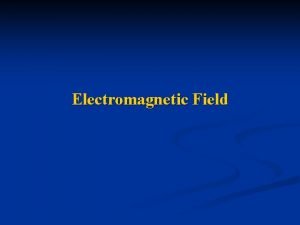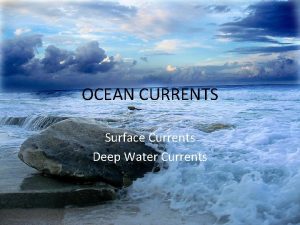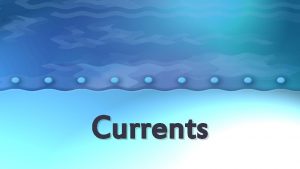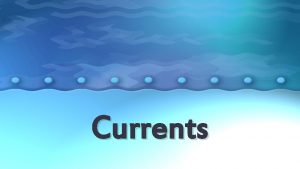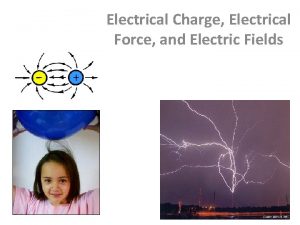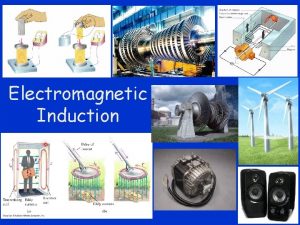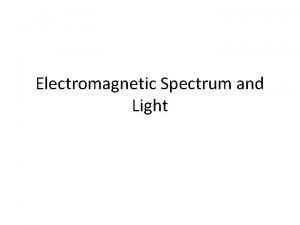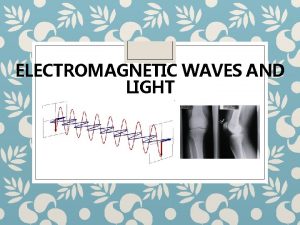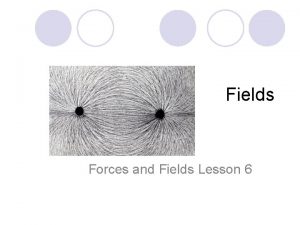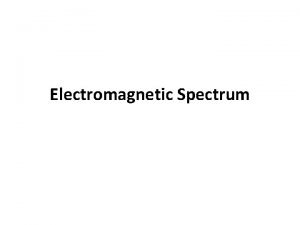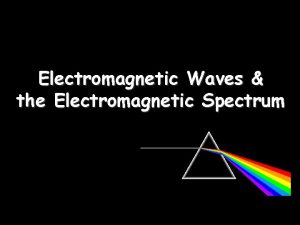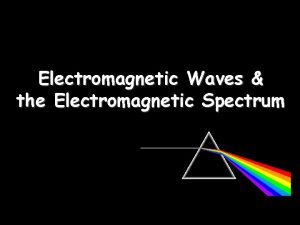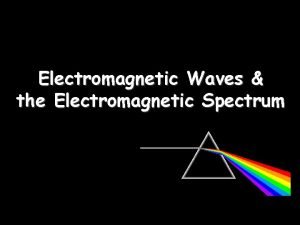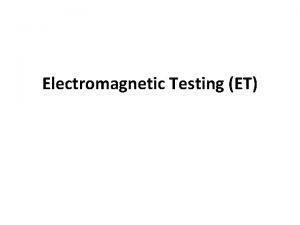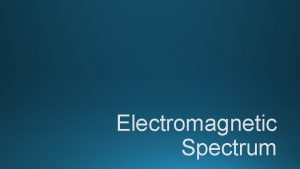Lecture 6 Electrical Currents and Electromagnetic Fields Effects



























































- Slides: 59

Lecture #6 Electrical Currents and Electromagnetic Fields Effects on Biological Objects

Plan of the lecture 1. 2. 3. 4. 5. 6. Electrical properties of biological tissues Direct current effect on biological tissues Pulse current effect on biological tissues Alternating electromagnetic field effect on biological tissues Direct electric and magnetic fields effect on biological tissues th

A great number of diagnostic and therapeutic methods of modern medicine are based on effects developing in human body tissues under the influence of external electrical currents and electromagnetic fields.

Electrical currents and fields effect on biological objects depends on: 1) Properties of External electrical current or fields 2) Own Electrical activity of biological tissue

1. Electrical properties of Biological Tissues All biological tissue can be divided into conductors (conduct electric current well) and dielectrics (conduct electric current poorly) : conductors are cerebro-spinal fluid, blood, lymph, dielectrics are bone without periosteum, nervous, fatty tissue, dried-up skin.

Electrical specific conductivity ( ) for various biological tissues : Biological tissue Specific conductivity , Ohm-1 m-1 Cereb Blood Muscu Nervous Fatty Skin Bone lar tissue (dried without rotissue -up) spinal perifluid osteum 1. 8 0. 6 0. 5 7· 10 -2 3· 10 -2 10 -5 10 -7

• The best conductor of electrical current is cerebrospinal fluid. • The best dielectric is bone without periosteum.

. Two classes of conductors: first - fine metals (free charge carriers are electrons), second – electrolytes (free charge carriers are ions). Biological tissues are second class conductors, or ionic conductors (it means, current carriers in biological tissues are ions).

Electrical properties of biological tissue depend on its Impedance (Z) is a Total Resistance, it has two components: • Active resistance (R) Resistor Symbol • Reactive resistance (X): - capacitive (XC) Capacitor Symbol - inductive (XL ) Inductor Symbol


Biological tissues have only: • active resistance (R) • capacitive resistance (XC ) • Inductive resistance XL of biological tissue is zero XL ≈ 0 !!!


• Due to capacity resistance (XC ) electrical properties of the biological tissue are different for direct and alternating currents: Direct Current (DC) doesn’t pass through structures with the capacity properties, and Alternating Current (AC) passes (the bigger frequency of alternating current, the better it passes).

• Human body has capacity properties (XC ) due to capacitor analogs in the body : 1) an intact cell Cell membrane is a dielectric; cell content and intercellular fluid are conductors. Membrane is located between two conductors, like a dielectric layer between two conductors in a capacitor. 2) tissues-dielectrics and tissues-conductors

• Dependence of tissue impedance Z on alternating current frequency ω : solid line – for alive tissue, dotted line – for dead tissue • When frequency ω increases, the tissue impedance modulus decreases (solid line), but not to zero, up to constant value (dotted line).

• Coefficient of dispersion (К) is calculated for evaluation of tissues functional state, widely used in transplantology : Zlf is impedance at low frequencies (102 -104 Hz); Zhf is impedance at high frequencies (106 -108 Hz) • If К=1 , the biological tissue is dead; • If К>1 , the biological tissue is alive.

Electrical equivalent of a biological tissue is an electrical circuit having impedance dependence on alternating current frequency the same as the biological tissue; • it consists of two resistors (R 1 and R 2) and one capacitor (C) resistor R 1 - corresponds to intercellular fluid, resistor R 2 - corresponds to intracellular contents, capacitor C - corresponds to cell membranes.

2. Electrical currents effects on biological tissues Electrical current effect on tissues depends on current type. Basic types of current : 1. direct current 2. alternating current 3. pulse current

1. Direct current 2. Alternating current

3. Pulse current Electrical pulses can have different shape – rectangular, triangular, trapezoid etc.

Currents that can change in time are divided into pulse and alternating one. • Alternating current - changes in time according to the harmonic low (a sine or a cosine law). • Pulse current - depends on time periodically but not harmonically. Single electrical pulses are also used in medicine.

1. Direct current (DC) Under the influence of DC the positive and negative ions in a tissue move in the opposite sides: positive ions (cations) move to the cathode (-) and accumulate under it; negative ions (anions) move to the anode (+). • The main mechanism of direct current effect on biological tissues is change of usual ion concentrations in different parts of tissues.

Medical methods based on application of Direct Current : 1. Galvanization 2. Medical electrophoresis

1. Galvanization : • • • Voltage is U=60 -80 V; current density is j ≤ 1 A·m-2 Device for galvanization is an alternative current rectifier. Electrodes used to get current to a patient are made of sheet lead or foil. Hydrophilic layers wet with water or physiological solution are placed between a patient’s skin and the electrodes.

Response reactions of the human organism on DC: 1. Stimulation of blood circulation, lymph circulation, metabolism 2. Irritation of the tissues under cathode (“-” electrode) and decrease of the tissues sensitivity under anode (“+” electrode) - the effect of local analgesia (pain relief).

2. Medical electrophoresis is a therapeutic method of introducing of medical substances through the skin or mucous membranes under the influence of DC. • Medical electrophoresis is performed similar to galvanization but one of hydrophilic layers is wet not with water but with a special medicine solution.

• Introducing of medical substances by means of electrophoresis is possible if a medicine, dissolving in water, forms ions. • Anions are introduced to patient from under cathode, • cations are introduced to patient from under anode. Electrodes Medical substance

2. Pulse Current The basic mechanism of pulse currents effect on biological objects is the irritation of excitable tissues. Excitable tissues: • muscular • nervous • glandular

• Front is a pulse section that corresponds to voltage or current growth as well as their diminution (back front or cut). • Amplitude is modulus of voltage or current maximum value (Umax or Imax correspondingly). • Pulse duration is a time interval during which voltage (or current) exceeds 0, 1·Umax (or 0, 1·Imax for current).

Front steepness (S) is determined as follows where is a duration of growth (or diminution) of pulse front when voltage ranges between 0, 1·Umax and 0, 9·Umax. Pulse current is characterized by a period of pulse repetition (T) and pulse repetition frequency , at that .

Irritation action is a result of generation of an action potential in tissue cells. Irritation action depends on • pulse amplitude • pulse steepness • pulse frequency • pulse duration 1) The tissue irritation is possible if pulse amplitude exceeds certain minimum value. Minimum current value when response reaction (irritation) starts is called threshold current (Ithr).

2) The more pulse front steepness is, the more current irritation action. • Du Bois-Reymond law describes this phenomenon: an electric current irritation action is directly proportional to the rate of current increasing (or decreasing) that is proportional to a derivative of current with respect to time.

3) As pulse duration increases its irritation action on excitable tissues increases, i. e. threshold current decreases. • The method of electrodiagnostics is based on this conclusion - a method of examining of tissue excitability properties by means of determination of dependence of a threshold current upon pulse duration (τ) when single rectangular pulses irritate tissue. • Hoorweg-Weiss-Lapicque equation : where a and b are constants.

• From the diagram the more pulse duration, the less the threshold current depends on and tends to a certain limiting value that is called a rheobase (Re) in electrophysiology. • Rheobase is equal to a limit to which threshold current tends when pulse duration tends to infinity Other words, rheobase is determined as the value of threshold current when it does not depend upon pulse duration. ithr

• Chronaxie (Chr) is one more feature that describes tissue exciting properties as well as rheobase. Chronaxie is the pulse duration at which threshold current is equal to doubled rheobase. • Values of parameters a and b in Hoorweg-Weiss. Lapicque equation are determined by rheobase and chronaxie values. Hence, Hoorweq-Weiss-Lapicque equation can be presented like • Rheobase and chronaxie certain values are characteristic for the exciting tissues state. At different pathological states these parameters change.

Medical methods based on use of Pulse Current : 1. 2. 3. 4. Pacing Defibrillation Electrogymnastics Electrosleeping

1. Pacing • • • In normal state pulses causing heart systoles are produced by a sine node (nodus sinuatrialis) called a rhythm driver. If sine node does not execute its function, external rhythm driver (or heart pacemaker) is used. Heart pacemaker is carried or implanted cardiological electrical stimulator. Heart pacemaker generates electrical pulses with repetition frequency of 1 -1. 2 Hz and pulse duration of 0. 8 – 3 ms.

• 2. Defibrillation Defibrillator is used during cardiac arrest or heart ventricle fibrillation, i. e. when separate muscle fibers are contracted irregularly as a result of their irritation by each other. Defibrillator produces single high voltage electrical pulses (discharges) that cause great contractions of heart muscle and restoration of regular heart rhythm. Voltage equal to 8 k. V is commonly used. In case of unsuccessful attempt to start the heart a greater voltage is used for the following attempts.

3. Electrogymnastics (electrical exercises for muscles) support muscle tonus, improve circulation of the blood and metabolism in weak muscles or in muscles with bad innervations, support their ability for contraction. • Pulse current with pulses of a triangle shape with pulse duration of 1 -1. 5 ms and repetition frequency of 100 Hz as well as pulses of an exponential shape with pulse duration of 3 -60 ms and repetition frequency of 8 -80 Hz are used for electrical exercises.

4. Electrosleeping (electrical sleep) • is a method of inhibition of central nervous system by a pulse current of a rectangular shape with pulse duration of 0. 1 -1 ms and repetition frequency of 5 -150 Hz.

3. Alternating Current (AC) AC effect on tissues can be different and depends on its frequency : • at low frequencies AC causes irritation of excitable tissues (similar to pulse current); • at high frequencies AC causes thermal effect (tissue heating).

Dependence of threshold current (ithr) upon frequency ( ) is defined by Nernst law: • in frequency range from 100 to 300 Hz threshold current is proportional to square root from current frequency • in frequency range from 50 to 300 k. Hz threshold current is proportional to current frequency where k 1 and k 2 are certain constants. In case of alternating current threshold current is also called perception current.

Medical methods based on use of Alternating Current : 1. Rheography 2. Diathermy (diathermocoagulation, diathermotomy) 3. Local D’Arsonvalisation

1. Rheography (or impedance-plethysmography, or rheoplethysmo-graphy) is diagnostic method based on registration of changing of tissue impedance Z that takes place due to change in tissue filling with the blood (that was caused by heart functioning) At frequency 30 Hz current does not irritate excitable tissues (currents strength is less then threshold current).

• When cerebrum is examined with the help of rheography we get a rheoencephalogram, • when heart is examined with the help of rheography, we get a rheocardiogram. • Arterial vessels of lungs, liver and extremities can be examined with the help rheography. In stomatology vessels of paradont, mouth mucous membrane, salivary glands etc. can be examined with the help of rheography.

• Rheodentography - a method similar to rheography, is used in stomatology : tooth pulp is examined. • An alternating current of 0. 5 -1 MHz frequencies is used.

2. Diathermy • is based on heating effect when alternating current flows through tissues. • There are therapeutic diathermy and surgical diathermy (electrical surgery), which, in its turn, is divided into diathermotomy and diathermocoagulation. • When diathermy is used a specific heat power (an amount of heat evolved per 1 second in 1 m 3 of tissue) of current flowing through the tissue is defined by the formula : where q is specific heat power ; j is current density; ρ is resistivity of tissue through which current flows.

• In electrical surgery - the current of 10 MHz frequency is used. Two electrodes are applied for it: one electrode have a great area of contact with patient’s body and the other electrode is sharp. • During diathermocoagulation (j = 6… 10 m. А/mm 2) there is possibility to ‘seal’ blood vessels due to the effect of coagulation. • During diathermotomy (j ≈ 40 m. А/mm 2) a sharp electrode acts as an electrical knife, which cuts tissue by burning it. Diathermotomy is good for a surgeon, as this method is practically bloodless because the vessels are cut and sealed simultaneously.

• Local D’Arsonvalisation. When certain methods used currents are applied, the current affecting the patient is an alternating and a pulse at the same time. • So, at local D’Arsonvalisation the alternating current of 100 -400 k. Hz frequency acts at a patient, but the current is applied to him like pulses with repetition frequency of 50 Hz. In this case the voltage is 10 k. V.

ALTERNATING ELECTROMAGNETIC FIELD EFFECT ON BIOLOGICAL TISSUES • Electrical currents can be induced in tissues without electrodes. If tissues (some parts of human body) are placed into an alternating electromagnetic field, alternating currents are induced in them. Heating of tissues with the help of currents induced by an alternating field is the base of the following methods, such as inductothermy, UHF-therapy (UHF – ultrahigh frequencies), and microwave therapy.

• In the course of inductothermy an alternating magnetic field which oscillation frequency is within the range of 10 -15 MHz effect patient’s tissues. • A standard instrument for inductothermy produces magnetic field changing with a frequency of 13. 56 MHz. An alternating magnetic field induces eddy currents in tissues, when those currents flow tissues are heated and heat is evolved.

• In the course of inductothermy a specific heat power is defined by the formula • where k is proportionality factor; ω is cyclic frequency of alternating magnetic field ; B 0 is amplitude of magnetic induction. • It follows from the formula that tissues having less specific resistance (i. e. those tissues that are good conductors) are heated better. • The tissues are heated effectively up to the depth of 6 -8 cm. An increase of temperature in tissues intensify the circulation of the blood in them, causes different ferments activation. In the course of inductothermy human body immune system is being stimulated.

• UHF-therapy. In the course of UHF-therapy an alternating electric field of UHF-range (frequencies of 30 -300 MHz) effect on a patient’s tissues. • A standard instrument for UHF-therapy induces electromagnetic oscillations of 40. 58 MHz frequency. In this case the wavelength is about 7. 5 m.

• A specific heat power for tissues-dielectrics under UHF-therapy is determined by the formula • where E is a root-mean-square value of electricfield intensity ( , where E 0 - is the amplitude of electric-field intensity); ε is the dielectric permittivity; ε 0 is the electric constant; δ is the dielectric loss angle.

• Dielectric loss angle is phase difference between sum current ( ) and its reactive component. • Vector diagram: - reactive component current, - sum current, φ - a phase angle between and U in a circuit of an alternating current, consisting of resistor R and capacitor C, δ - dielectric loss angle.

• Superhigh frequency therapy (SHF-therapy). If SHF-therapy is used for heating patient’s tissues, it means that patient’s tissues are affected by electromagnetic waves with frequency within the range of 300 MHz – 30 GHz. • The commonly used devices are those ones that produce electromagnetic waves from the following standard values of wavelength: for decimetric waves (DMW) therapy – 65. 2 cm ( ), for microwave (MW) therapy – 12. 6 cm ( ). • Decimetric waves and microwave therapies differ from each other in the depth of radiation penetration in tissues. When decimetric therapy is used, the depth of penetration is 9 cm; when microwave therapy is used, the depth of penetration is 3 -5 cm. • At SHF-therapy the muscle tissues and the blood are heated well.

DIRECT ELECTRIC AND MAGNETIC FIELDS EFFECT ON BIOLOGICAL TISSUES • Direct electric field influence on tissues causes dielectric polarization due to molecule reorientation; in this case they behave as dipoles. It results in ions shift and change of their concentration in different sections of tissues. Ions shift lasts until electric field that they have developed will not compensate external electric field effect on ions. • This results in change of functional stat of central nervous system that is shown in predominance of inhibitory processes, ascension of neurologic level, sleep improvement etc.

• Such methods as electrostatic shower (or franclinization) and aeroionic therapy are used. At that a patient is placed in a strong electrostatic field (voltage up to 50 k. V is used) where partial air ionization occurs. As this takes place, aeroions are produced as well as air ionization products – ozone and ozone oxides that irritate skin receptors and mucous membrane receptors of respiratory tract.

• Direct and low frequency magnetic fields biological effect on human body is not studied enough. The change of tissue agent diffusion rate, change of rate and direction of biological reactions, change of water structure and some other effects happened upon subcellular level are supposed to take place in magnetic fields. • There is information on some essential process stimulation as well as depression in human body under action of magnetic fields. • Direct and low frequency alternating magnetic field medical effect on human body is called magnetic therapy.
 Electric currents and magnetic fields
Electric currents and magnetic fields Visualizing magnetic field
Visualizing magnetic field Compared with surface currents deep currents are
Compared with surface currents deep currents are Red fields
Red fields Electrical currents
Electrical currents Electrical currents
Electrical currents 01:640:244 lecture notes - lecture 15: plat, idah, farad
01:640:244 lecture notes - lecture 15: plat, idah, farad Ocean currents waves and tides
Ocean currents waves and tides How do currents and magnets exert forces on each other
How do currents and magnets exert forces on each other Types of medium frequency current
Types of medium frequency current Currents and magnets summarizer
Currents and magnets summarizer Gyre
Gyre How electromagnet works
How electromagnet works Ocean waves
Ocean waves Electric forces and fields concept review
Electric forces and fields concept review We plow the fields and scatter
We plow the fields and scatter Rodan and fields tax write offs
Rodan and fields tax write offs Learning: module 26: magnetic forces and fields
Learning: module 26: magnetic forces and fields Scrap heap magnet diagram
Scrap heap magnet diagram Chapter 16: electric forces and fields answers
Chapter 16: electric forces and fields answers Banana dresser grammar potato revive
Banana dresser grammar potato revive Current equation
Current equation 3 major fields of psychology
3 major fields of psychology Chapter 33 conceptual physics
Chapter 33 conceptual physics Finite fields in cryptography and network security
Finite fields in cryptography and network security What does the diagram illustrate about turbidity currents?
What does the diagram illustrate about turbidity currents? Ocean currents vocabulary
Ocean currents vocabulary Surface current definition
Surface current definition Upwelling in the ocean
Upwelling in the ocean Low frequency current
Low frequency current Longshore currents move sediment as they _____.
Longshore currents move sediment as they _____. Convection
Convection Coonvection
Coonvection Convection current lab
Convection current lab What causes wind to blow brainpop
What causes wind to blow brainpop Cause of currents
Cause of currents Currents waves
Currents waves What is the primary driving force of surface-ocean currents
What is the primary driving force of surface-ocean currents Currents the band
Currents the band Ocean currents
Ocean currents Wind currents definition geography
Wind currents definition geography Ocean currents vocabulary
Ocean currents vocabulary Write a matrix equation that determines the loop currents
Write a matrix equation that determines the loop currents Shortest short stories
Shortest short stories Convection currents definition
Convection currents definition Whats convection currents
Whats convection currents Line currents
Line currents What is the primary cause of surface currents
What is the primary cause of surface currents Ocean currents
Ocean currents In a y-connected source feeding a ∆-connected load,
In a y-connected source feeding a ∆-connected load, In a triangle connected source feeding
In a triangle connected source feeding Ocean currents project
Ocean currents project Scientists think that convection currents flow in earth's *
Scientists think that convection currents flow in earth's * Persistent currents
Persistent currents Persistent currents
Persistent currents Binary signal
Binary signal Persistent currents
Persistent currents High ohmic series resistance with microammeter
High ohmic series resistance with microammeter Persistent currents
Persistent currents As cold air sinks
As cold air sinks




